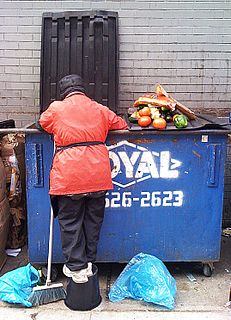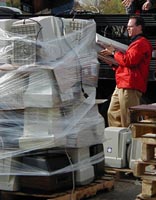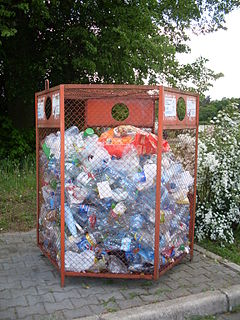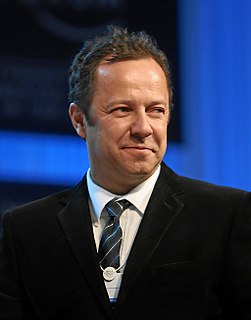
Dumpster diving, is the salvaging of waste in large commercial, residential, industrial and construction containers to find items that have been discarded by their owners, but that may prove useful to the picker. It is not confined to dumpsters specifically, and may cover standard household waste containers, curb sides, landfills or small dumps.

Recycling is the process of converting waste materials into new materials and objects. It is an alternative to "conventional" waste disposal that can save material and help lower greenhouse gas emissions. Recycling can prevent the waste of potentially useful materials and reduce the consumption of fresh raw materials, thereby reducing: energy usage, air pollution, and water pollution.
Garbology is the study of modern refuse and trash as well as the use of trash cans, compactors and various types of trash can liners. As an academic discipline it was pioneered at the University of Arizona and long directed by William Rathje. The project started in 1973, originating from an idea of two students for a class project. It is a major source of information on the nature and changing patterns in modern refuse, and thereby, human society.

Guanabara Bay is an oceanic bay located in Southeast Brazil in the state of Rio de Janeiro. On its western shore lies the city of Rio de Janeiro and Duque de Caxias, and on its eastern shore the cities of Niterói and São Gonçalo. Four other municipalities surround the bay's shores. Guanabara Bay is the second largest bay in area in Brazil, at 412 square kilometres (159 sq mi), with a perimeter of 143 kilometres (89 mi).

Zero Waste is a philosophy that encourages the redesign of resource life cycles so that all products are reused. The goal is for no trash to be sent to landfills, incinerators, or the ocean. The process recommended is one similar to the way that resources are reused in nature. The definition adopted by the Zero Waste International Alliance (ZWIA) is:
Zero Waste: The conservation of all resources by means of responsible production, consumption, reuse, and recovery of all products, packaging, and materials, without burning them, and without discharges to land, water, or air that threaten the environment or human health.

Computer recycling, electronic recycling or e-waste recycling is the disassembly and separation of components and raw materials of waste electronics. Although the procedures of re-use, donation and repair are not strictly recycling, they are other common sustainable ways to dispose of IT waste.

Plastic recycling is the process of recovering scrap or waste plastic and reprocessing the material into useful products. Since the vast majority of plastic is non-biodegradable, recycling is a part of global efforts to reduce plastic in the waste stream, especially the approximately 8 million tons of waste plastic that enters the Earth's ocean every year.

When structures made of concrete are demolished or renovated, concrete recycling is an increasingly common method of utilizing the rubble. Concrete was once routinely trucked to landfills for disposal, but recycling has a number of benefits that have made it a more attractive option in this age of greater environmental awareness, more environmental laws, and the desire to keep construction costs down.

Waste collection is a part of the process of waste management. It is the transfer of solid waste from the point of use and disposal to the point of treatment or landfill. Waste collection also includes the curbside collection of recyclable materials that technically are not waste, as part of a municipal landfill diversion program.

A waste picker is a person who salvages reusable or recyclable materials thrown away by others to sell or for personal consumption. There are millions of waste pickers worldwide, predominantly in developing countries, but increasingly in post-industrial countries as well.
This article examines recycling in the United States. In 2014, the recycling/composting rate for municipal solid waste in the US was 34.6%. Since there is no national law that mandates recycling, state and local governments often introduce their own recycling requirements. A number of U.S. states, including California, Connecticut, Delaware, Hawaii, Iowa, Maine, Massachusetts, Michigan, New York, Oregon, and Vermont have passed laws that establish deposits or refund values on beverage containers while other jurisdictions rely on recycling goals or landfill bans of recyclable materials.

Connecticut Resources Recovery Authority is a quasi-public agency that provides single-stream recycling and trash disposal for Connecticut cities and towns. It owns a trash-to-energy plant in Hartford, oversees another in Preston, and financed the development of others in Bridgeport and Wallingford.

As a nation, Americans generate more waste than any other nation in the world, officially with 4.4 pounds (2.0 kg) of municipal solid waste (MSW) per person per day, with another study estimating 7.1 pounds per capita per day. Fifty five percent of this waste is contributed as residential garbage, while the remaining forty five percent of waste in the U.S.'s ‘waste stream' comes from manufacturing, retailing, and commercial trade in the U.S. economy. Based on proprietary data released to the public, Nevada was named America's "Most Wasteful State" for the years 2005-2010; where each resident threw away over 14 pounds of non-recycled, unreused items, often ending up into landfills and incinerators per day, eight pounds over the national state daily throwaway average. "Wasteful" states Michigan, New Mexico, Wisconsin and Oregon as well as Washington also dominated the list's 5-year period.
Resource recovery is using wastes as an input material to create valuable products as new outputs. The aim is to reduce the amount of waste generated, therefore reducing the need for landfill space and also extracting maximum value from waste. Resource recovery delays the need to use raw materials in the manufacturing process. Materials found in municipal solid waste can be used to make new products. Plastic, paper, aluminium, glass and metal are examples of where value can be found in waste.

Cartonera is a social, political and artistic publishing movement that began in Argentina in 2003 and has since spread to countries throughout Latin America and, more recently, to Europe and Africa. The founders, Washington Cucurto, Javier Barilaro, and Fernanda Laguna started Eloísa Cartonera in Buenos Aires in response to the 2001 economic crisis during which the Argentine peso plummeted to one third of its value. The tough economic conditions led to an increase in the number of cartoneros, people who make their living collecting and selling salvaged materials to recycling plants.

Pennsylvania is a northeastern commonwealth located in the United States of America. It was one of the 13 original colonies. Pennsylvania is home to a population of 12,802,503 individuals and various different types of environments. Pennsylvania is known for its many hills, plateaus, mountains and valleys. In fact, Pennsylvania is 50 percent forest land with the only lowlands located in the southeast.
Landfill Harmonic is a 2015 documentary film directed by Brad Allgood and Graham Townsley. It stars and tells the story of Paraguayan music teacher Favio Chavez and his Recycled Orchestra of Cateura, a children's orchestra in Paraguay which performs with materials recycled from a trash landfill near Asuncion. In Paraguay, the current administrative director of the orchestra is reported to the prosecution for alleged lack of transparency with donations.
















